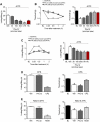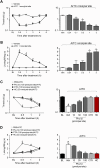The peptide Phα1β, from spider venom, acts as a TRPA1 channel antagonist with antinociceptive effects in mice
- PMID: 27759880
- PMCID: PMC5341489
- DOI: 10.1111/bph.13652
The peptide Phα1β, from spider venom, acts as a TRPA1 channel antagonist with antinociceptive effects in mice
Abstract
Background and purpose: Peptides from venomous animals have long been important for understanding pain mechanisms and for the discovery of pain treatments. Here, we hypothesized that Phα1β, a peptide from the venom of the armed spider Phoneutria nigriventer, produces analgesia by blocking the TRPA1 channel.
Experimental approach: Cultured rat dorsal root ganglion (DRG) neurons, human fetal lung fibroblasts (IMR90) or HEK293 cells expressing the human TRPA1 (hTRPA1-HEK293), human TRPV1 (hTRPV1-HEK293) or human TRPV4 channels (hTRPV4-HEK293), were used for calcium imaging and electrophysiology. Nociceptive responses induced by TRPA1, TRPV1 or TRPV4 agonists or by bortezomib were investigated in mice.
Key results: Phα1β selectively inhibited calcium responses and currents evoked by the TRPA1 agonist, allyl isothiocyanate (AITC), on hTRPA1-HEK293, IMR90 fibroblasts and DRG neurons. Phα1β did not affect calcium responses evoked by selective TRPV1 (capsaicin) or TRPV4 (GSK 1016790A) agonists on the various cell types. Intrathecal (i.t.) and intraplantar (i.pl.) administration of low doses of Phα1β (up to 300 pmol per paw) attenuated acute nociception and mechanical and cold hyperalgesia evoked by AITC (i.t. or i.pl.), without affecting responses produced by capsaicin or hypotonic solution. Notably, Phα1β abated the TRPA1-dependent neuropathic pain-like responses induced by bortezomib. In vitro and in vivo inhibition of TRPA1 by Phα1β was reproduced by a recombinant form of the peptide, CTK 01512-2.
Conclusions and implications: Phα1β and CTK 01512-2 selectively target TRPA1, but not other TRP channels. This specific action underlines the potential of Phα1β and CTK 01512-2 for pain treatment.
© 2016 The British Pharmacological Society.
Figures





Similar articles
-
Phα1β toxin prevents capsaicin-induced nociceptive behavior and mechanical hypersensitivity without acting on TRPV1 channels.Neuropharmacology. 2013 Aug;71:237-46. doi: 10.1016/j.neuropharm.2013.04.001. Epub 2013 Apr 15. Neuropharmacology. 2013. PMID: 23597507
-
Recombinant Production, NMR Solution Structure, and Membrane Interaction of the Phα1β Toxin, a TRPA1 Modulator from the Brazilian Armed Spider Phoneutria nigriventer.Toxins (Basel). 2023 Jun 3;15(6):378. doi: 10.3390/toxins15060378. Toxins (Basel). 2023. PMID: 37368679 Free PMC article.
-
The TRPA1 channel mediates the analgesic action of dipyrone and pyrazolone derivatives.Br J Pharmacol. 2015 Jul;172(13):3397-411. doi: 10.1111/bph.13129. Epub 2015 Apr 24. Br J Pharmacol. 2015. PMID: 25765567 Free PMC article.
-
Analgesic effects of Phα1β toxin: a review of mechanisms of action involving pain pathways.J Venom Anim Toxins Incl Trop Dis. 2021 Nov 22;27:e20210001. doi: 10.1590/1678-9199-JVATITD-2021-0001. eCollection 2021. J Venom Anim Toxins Incl Trop Dis. 2021. PMID: 34868281 Free PMC article. Review.
-
[Activation and regulation of nociceptive transient receptor potential (TRP) channels, TRPV1 and TRPA1].Yakugaku Zasshi. 2010 Mar;130(3):289-94. doi: 10.1248/yakushi.130.289. Yakugaku Zasshi. 2010. PMID: 20190512 Review. Japanese.
Cited by
-
Exploring the 'cold/hot' properties of traditional Chinese medicine by cell temperature measurement.Pharm Biol. 2020 Dec;58(1):208-218. doi: 10.1080/13880209.2020.1732429. Pharm Biol. 2020. PMID: 32114881 Free PMC article.
-
Targeting nociceptive transient receptor potential channels to treat chronic pain: current state of the field.Br J Pharmacol. 2018 Jun;175(12):2185-2203. doi: 10.1111/bph.14044. Epub 2017 Nov 6. Br J Pharmacol. 2018. PMID: 28924972 Free PMC article. Review.
-
Pathological Mechanisms of Bortezomib-Induced Peripheral Neuropathy.Int J Mol Sci. 2021 Jan 17;22(2):888. doi: 10.3390/ijms22020888. Int J Mol Sci. 2021. PMID: 33477371 Free PMC article. Review.
-
A Systematic Review of Traditionally Used Herbs and Animal-Derived Products as Potential Analgesics.Curr Neuropharmacol. 2021;19(4):553-588. doi: 10.2174/1570159X18666200808151522. Curr Neuropharmacol. 2021. PMID: 32781962 Free PMC article.
-
Animal models of chemotherapy-induced peripheral neuropathy for hematological malignancies: A review.Ibrain. 2022 Dec 22;9(1):72-89. doi: 10.1002/ibra.12086. eCollection 2023 Spring. Ibrain. 2022. PMID: 37786517 Free PMC article. Review.
References
-
- Andrade EL, Meotti FC, Calixto JB (2012). TRPA1 antagonists as potential analgesic drugs. Pharmacol Ther 133: 189–204. - PubMed
Publication types
MeSH terms
Substances
LinkOut - more resources
Full Text Sources
Other Literature Sources
Miscellaneous

